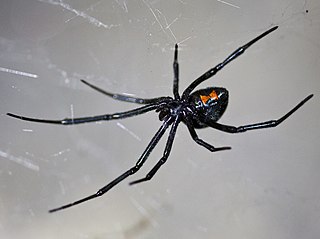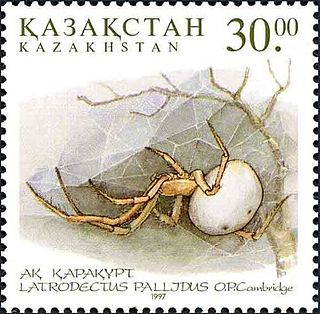
Latrodectus mactans, known as southern black widow or simply black widow, and the shoe-button spider, is a venomous species of spider in the genus Latrodectus. The females are well known for their distinctive black and red coloring and for the fact that they will occasionally eat their mate after reproduction. The species is native to North America. The venom is rarely fatal to healthy humans.

Latrodectus is a broadly distributed genus of spiders with several species that, together, are referred to as true widows. This group is composed of those often loosely called black widow spiders, brown widow spiders, and similar spiders. However, such general "common names" are of limited use as the diversity of species is much greater. A member of the family Theridiidae, this genus contains 32 species, which include several North American "black widows". In addition to these in North America are also the red widow Latrodectus bishopi and the brown widow Latrodectus geometricus, which, in addition to North America, has a much wider geographic distribution. Elsewhere, others include the European black widow, the Australian redback black widow, several different species in Southern Africa that can be called Button spiders, and the South American black widow spiders. Species vary widely in size. In most cases, the females are dark-coloured, but some may have lighter bodies or even reddish. Many can have red, white or brown markings on the upper-side (dorsal) of the abdomen. Some can be readily identifiable by reddish markings on the central underside (ventral) abdomen, which are often hourglass-shaped.

The redback spider, also known as the Australian black widow, is a species of highly venomous spider believed to originate in South Australia or adjacent Western Australian deserts, but now found throughout Australia, Southeast Asia and New Zealand, with colonies elsewhere outside Australia. It is a member of the cosmopolitan genus Latrodectus, the widow spiders. The adult female is easily recognised by her spherical black body with a prominent red stripe on the upper side of her abdomen and an hourglass-shaped red/orange streak on the underside. Females usually have a body length of about 10 millimetres (0.4 in), while the male is much smaller, being only 3–4 mm (0.12–0.16 in) long.

Latrodectus bishopi is the scientific name for the red widow spider, which is endemic to certain habitats of central and southern Florida, where it lives primarily in sand dunes dominated by sand pine, Pinus clausa – a type of vegetation found only in peninsular Florida.
Black widow may refer to:

The katipō is an endangered species of spider native to New Zealand. It is one of many species in the genus Latrodectus, such as the Australian redback, and the North American black widow. The species is venomous to humans, capable of delivering a potentially dangerous bite. It is a small to medium-sized spider, with the female having a round black or brown pea-sized body. Red katipō females, found in the South Island and the lower half of the North Island, are always black, and their abdomen has a distinctive red stripe bordered in white. In black katipō females, found in the upper half of the North Island, this stripe is absent, pale, yellow, or replaced with cream-coloured blotches. These two forms were previously thought to be separate species. The male is much smaller than the female and quite different in appearance: white with black stripes and red diamond-shaped markings. Katipō are mainly found living in sand dunes close to the seashore. They are found throughout most of coastal New Zealand except the far south and west. Katipō feed mainly on ground dwelling insects, caught in an irregular tangled web spun amongst dune plants or other debris.

Latrodectus geometricus, commonly known as the brown widow, brown button spider, grey widow, brown black widow, house button spider or geometric button spider, is one of the widow spiders in the genus Latrodectus. As such, it is a 'cousin' to the more infamous Latrodectus mactans. L. geometricus has black and white patterns on the sides of its abdomen as well as an orange-yellow colored hourglass shape. Their eggs are easily identified by points that project from all over the egg sacs. L. geometricus are found all over the world, but are believed to originate in South America. Their bites, though painful, are not considered to be dangerous.
Button spider is a common name used in Southern Africa to refer to local members of the spider genus, Latrodectus, the family Theridiidae. There are both black and brown button spiders in Southern Africa, that are known elsewhere as widow spiders. Seven Latrodectus species can be found in Southern Africa; six of them are native, one is possibly imported.

Latrodectus tredecimguttatus, also known as the Mediterranean black widow, or the European black widow, is a species in the genus Latrodectus of the widow spiders. It is commonly found throughout the Mediterranean region, ranging from southern Iberia to southwest and central Asia, hence the name. Specimens from central Asia are also known by the binomial name Latrodectus lugubris; that name, however, is now considered improper, though it is still commonly found in the literature. Latrodectus tredecimguttatus was previously considered a subspecies of Latrodectus mactans.

A spider bite, also known as arachnidism, is an injury resulting from the bite of a spider. The effects of most bites are not serious. Most bites result in mild symptoms around the area of the bite. Rarely they may produce a necrotic skin wound or severe pain.

Steatoda grossa, commonly known as the cupboard spider, the dark comb-footed spider, the brown house spider, or the false widow, is a common species of spider in the genus Steatoda.

Latrodectus pallidus is a species of spider commonly found throughout North Africa, the Middle East, and central Asia. A common name in English is the white widow spider, and it is known in Russian as белый каракурт, or white steppe spider. It is a member of the genus Latrodectus, which includes species known as widow spiders, which is placed in the family Theridiidae. It occurs both in the steppes of southern Russia, Kazakhstan, and other southwest Asian countries, as well as in the desert regions of the Middle East. Compared to other widow spiders in the region, the white widow spider is comparatively rare.

Latrodectus variolus, the northern black widow spider or northern widow, is a species of spider in the genus Latrodectus of the family Theridiidae. The population is closely related to the southern black widow, Latrodectus mactans, and the western black widow, Latrodectus hesperus, of the genus.

Latrodectus hesperus, the western black widow spider or western widow, is a venomous spider species found in western regions of North America. The female's body is 14–16 mm in length and is black, often with an hourglass-shaped red mark on the lower abdomen. This "hourglass" mark can be yellow, and on rare occasions, white. The male of the species is around half this length and generally a tan color with lighter striping on the abdomen. The population was previously described as a subspecies of Latrodectus mactans and it is closely related to the northern species Latrodectus variolus. The species, as with others of the genus, build irregular or "messy" webs: unlike the spiral webs or the tunnel-shaped webs of other spiders, the strands of a Latrodectus web have no apparent organization.

Latrodectus indistinctus is a species of spider in the family Theridiidae, found in Namibia and South Africa. It is one of six species of Latrodectus found in southern Africa, four of which, including L. indistinctus, are known as black button or black widow spiders. Like all Latrodectus species, L. indistinctus has a neurotoxic venom. It acts on nerve endings, causing the very unpleasant symptoms of latrodectism when humans are bitten.

Latrodectism is the illness caused by the bite of Latrodectus spiders. Pain, muscle rigidity, vomiting, and sweating are the symptoms of latrodectism. Contrary to popular conception, latrodectism is very rarely fatal for humans, though domestic cats have been known to die due to convulsions and paralysis.

Latrodectus corallinus is a species of widow spider native to Argentina. It is approximately 12 millimetres (0.47 in) in size, and is primarily black with large, red markings on its abdomen, as well as a red, square-like ring under its abdomen.
Latrodectus apicalis, known as the Galapagos black widow, is endemic to the Galápagos Islands. Like many black widow spiders, it has a red or orange hourglass-shaped spot on the underside of the abdomen. It is venomous and sometimes hard to find.
Latrodectus erythromelas, is a species of venomous spider of the genus Latrodectus, commonly called widow spiders. It is native to India and Sri Lanka.

Latrodectus umbukwane, commonly known as the Phinda button spider, is a species of the spider in the genus Latrodectus described in 2019, named after the Phinda Private Game Reserve where research specimens were collected. As of 2019, it is known only from critically endangered sand forest environments in northern Zululand, KwaZulu-Natal, South Africa. It is believed to be the largest member of its genus.















